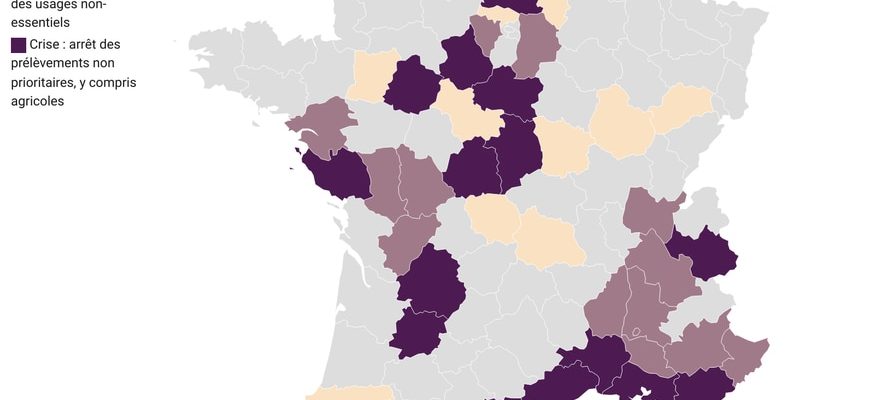The torrential rains of recent days in several regions have not made it possible to recharge the water tables: two thirds remain at low levels, while 37 departments are subject to water restrictions. “During May, the situation of the aquifers changed only slightly and remained generally unsatisfactory”, worried the Bureau of Geological and Mining Research (BRGM) in its inventory to June 1, published this Wednesday.
The organization responsible for monitoring groundwater tables notes that the levels of 66% of them are low (compared to 68% in April), or even very low for 19% of the water tables measured. 14% are even below monthly norms – they were 17% in April.
Crucial Reserves
The sheets constitute the main source of drinking water in France, the other being surface water (rivers, torrents, lakes, etc.). Extracted and then reprocessed, the water from these underground reserves represents the two-thirds drinking water consumption in the country. While fears of a drought comparable to that of summer 2022 are being felt, the groundwater level is also a worrying indicator. The current situation is comparable to that of last year (69% of levels below normal in May 2022), but more contrasted depending on the area.
“For a long time, we lived like spoiled children thinking that we were never going to run out of water”, had declared a few hours earlier the Minister for the Ecological Transition, Christophe Béchu, insisting on the “need to save more the water”. “Abundance is no longer in season” when it comes to water, he said.
The Southeast under surveillance
The minister reported “serious concerns” about certain regions, such as the Rhone corridor or the Mediterranean rim. The waterspouts of the last few days in the south “are mainly thunderstorms, therefore they were able to moisten some soils and green the vegetation, but most of them did not recharge the water tables”, which began to empty since mid -April, said Violaine Bault, hydrogeologist at BRGM during a videoconference, reports AFP.
Some regions are more affected: this is the case for certain aquifers from Dijonnais to Bas-Dauphiné, Provence and the Côte d’Azur or even Roussillon, which record very low levels. “For Var and Roussillon, it’s already too late”, whatever the rains that could fall, said Violaine Bault. In the case of Roussillon, the levels are so low that, in places, the water table risks infiltration of salt water, which can make it inedible, she warned. Conversely, the basement aquifers of the Armorican Massif, and from Brittany to the Vendée benefited from previous excess rainfall; just like others in Artois-Picardie, in Avesnois, and in Boulonnais.
Map of departments on drought alert in France in June 2023.
© / L’Express (figures: Ministry of Ecological Transition)
37 departments on drought alert
To cope, water restrictions were imposed by the prefects in 37 departments. In 9 of them, on drought “alert”, groundwater withdrawals for agricultural purposes are reduced (a drop of less than 50%) or prohibited up to three days a week. There are also restrictions on watering, filling and emptying swimming pools, washing vehicles and irrigating crops.
14 departments, including Martinique, are on “enhanced alert”, which implies that agriculture must this time not exceed 50% of withdrawals, or cannot use groundwater up to 3.5 days a week. Limitations on the use of water are reinforced, possibly going as far as a ban.
In 14 other departments in “crisis”, only priority uses of water are authorized, related to health, civil security, drinking water, sanitation. Agriculture, public spaces and certain domestic uses are excluded. Finally, the 22 departments in a state of “vigilance” are limited to incentive and information measures for individuals and professionals.
“In June and for the next quarter, groundwater levels should remain down” and “the situation should deteriorate” at different rates depending on the situations of tension in each zone, estimates the BRGM. Summer promises to be all the more complex as Météo-France forecasts for the period from June to August temperatures that will probably be higher than normal for the season, which implies more evaporation and irrigation needs.
